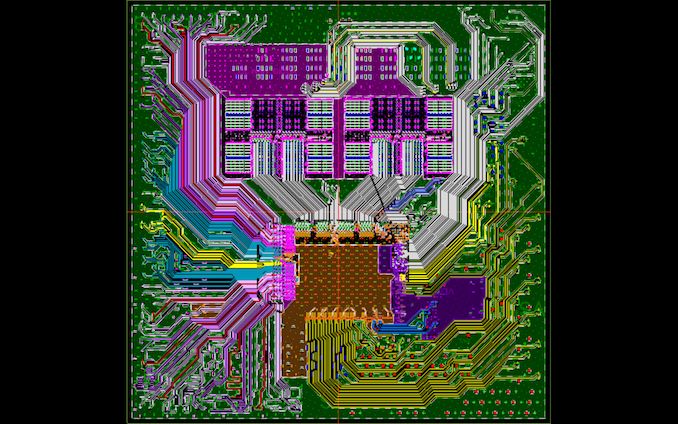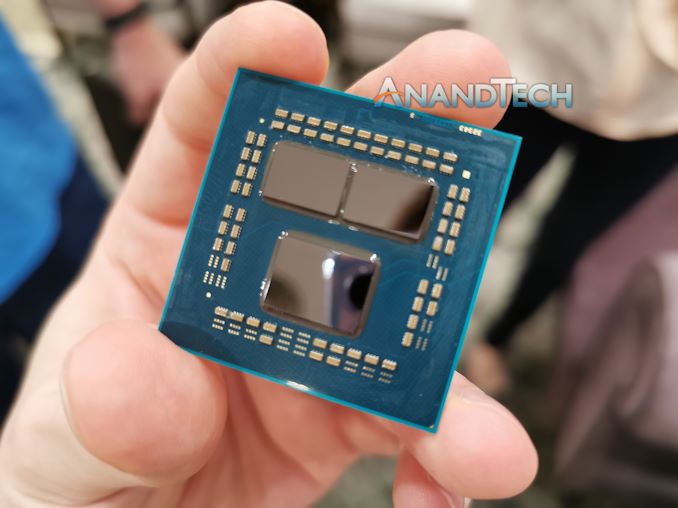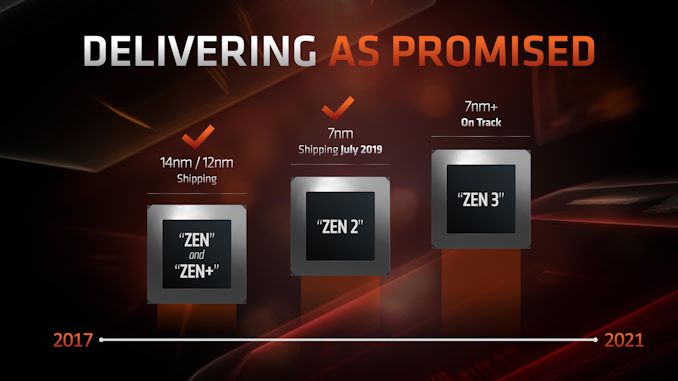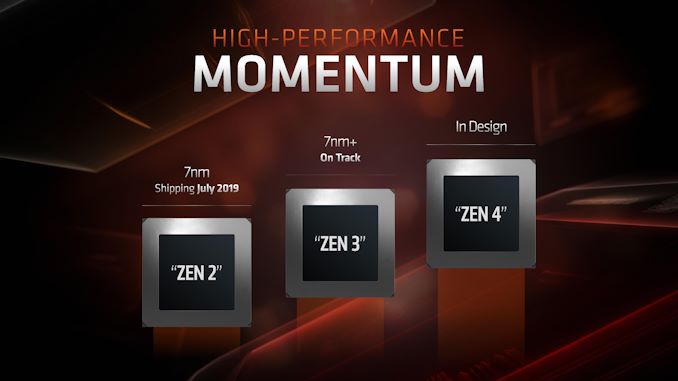AMD Zen 2 Microarchitecture Analysis: Ryzen 3000 and EPYC Rome
by Dr. Ian Cutress on June 10, 2019 7:22 PM EST- Posted in
- CPUs
- AMD
- Ryzen
- EPYC
- Infinity Fabric
- PCIe 4.0
- Zen 2
- Rome
- Ryzen 3000
- Ryzen 3rd Gen

Editor's Note: With Zen 2 set to launch tomorrow (7/7), here's our architecture analysis from last month for some timely background information.
We have been teased with AMD’s next generation processor products for over a year. The new chiplet design has been heralded as a significant breakthrough in driving performance and scalability, especially as it becomes increasingly difficult to create large silicon with high frequencies on smaller and smaller process nodes. AMD is expected to deploy its chiplet paradigm across its processor line, through Ryzen and EPYC, with those chiplets each having eight next-generation Zen 2 cores. Today AMD went into more detail about the Zen 2 core, providing justification for the +15% clock-for-clock performance increase over the previous generation that the company presented at Computex last week.
AMD’s Zen 2 Product Portfolio
The current products that AMD has announced that have Zen 2 cores include the Ryzen 3rd Generation consumer CPUs, known as the Ryzen 3000 family, and AMD’s next generation enterprise EPYC processor, known as Rome. As of today, AMD has announced explicit details of six consumer Ryzen 3000 processors, including core counts, frequencies, memory support, and power. Details about the server processor, aside from some peak values, are expected in due course over the next few months.
| AMD 'Matisse' Ryzen 3000 Series CPUs | |||||||||||
| AnandTech | Cores Threads |
Base Freq |
Boost Freq |
L2 Cache |
L3 Cache |
PCIe 4.0 |
DDR4 | TDP | Price (SEP) |
||
| Ryzen 9 | 3950X | 16C | 32T | 3.5 | 4.7 | 8 MB | 64 MB | 16+4+4 | 3200 | 105W | $749 |
| Ryzen 9 | 3900X | 12C | 24T | 3.8 | 4.6 | 6 MB | 64 MB | 16+4+4 | 3200 | 105W | $499 |
| Ryzen 7 | 3800X | 8C | 16T | 3.9 | 4.5 | 4 MB | 32 MB | 16+4+4 | 3200 | 105W | $399 |
| Ryzen 7 | 3700X | 8C | 16T | 3.6 | 4.4 | 4 MB | 32 MB | 16+4+4 | 3200 | 65W | $329 |
| Ryzen 5 | 3600X | 6C | 12T | 3.8 | 4.4 | 3 MB | 32 MB | 16+4+4 | 3200 | 95W | $249 |
| Ryzen 5 | 3600 | 6C | 12T | 3.6 | 4.2 | 3 MB | 32 MB | 16+4+4 | 3200 | 65W | $199 |
The Zen 2 design paradigm, compared to the first generation of Zen, has changed significantly. The new platform and core implementation is designed around small 8-core chiplets built on TSMC’s 7nm manufacturing process, and measure around 74-80 square millimeters. On these chiplets are two groups of four-cores arranged in a ‘core complex’, or CCX, which contains those four cores and a set of L3 cache – the L3 cache is doubled for Zen 2 over Zen 1.
Each full CPU, regardless of how many chiplets it has, is paired with a central IO die through Infinity Fabric links. The IO die acts as the central hub for all off-chip communications, as it houses all the PCIe lanes for the processor, as well as memory channels, and Infinity Fabric links to other chiplets or other CPUs. The IO die for the EPYC Rome processors is built on Global Foundries' 14nm process, however the consumer processor IO dies (which are smaller and contain fewer features) are built on the Global Foundries 12nm process.
The consumer processors, known as ‘Matisse’ or Ryzen 3rd Gen or Ryzen 3000-series, will be offered with up to two chiplets for sixteen cores. AMD is launching six versions of Matisse on July 7th, from six cores to sixteen cores. The six and eight-core processors have one chiplet, while above this the parts will have two chiplets, but in all cases the IO die is the same. This means that every Zen 2 based Ryzen 3000 processor will have access to 24 PCIe 4.0 lanes and dual channel memory. Based on the announcements today, the prices will range from $199 for the Ryzen 5 3600, up to $700+ for the sixteen core (we’re waiting on final confirmation of this price).
The EPYC Rome processors, built on these Zen 2 chiplets, will have up to eight of them, enabling a platform that can support up to 64 cores. As with the consumer processors, no chiplet can communicate directly with each other – each chiplet will only connect directly to the central IO die. That IO die houses links for eight memory channels, and up to 128 lanes of PCIe 4.0 connectivity.
AMD’s Roadmap
Before diving into the new product line, it is worth recapping where we currently sit in AMD’s planned roadmap.
In previous roadmaps, showcasing AMD’s movement from Zen to Zen 2 and Zen 3, the company has explained that this multi-year structure will showcase Zen in 2017, Zen 2 in 2019, and Zen 3 by 2021. The cadence isn’t exactly a year, as it has depended on AMD’s design and manufacturing abilities, as well as agreements with its partners in the foundries and the current market forces.
AMD has stated that its plan for Zen 2 was to always launch on 7nm, which ended up being TSMC’s 7nm (Global Foundries wasn’t going to be ready in time for 7nm, and ultimately pulled the plug). The next generation Zen 3 is expected to align with an updated 7nm process, and at this point AMD has not made any comment about a potential ‘Zen 2+’ design in the works, although at this point we do not expect to see one.
Beyond Zen 3, AMD has already stated that Zen 4 and Zen 5 are currently in various levels of their respective design stages, although the company has not committed to particular time frames or process node technologies. AMD has stated in the past that the paradigms of these platforms and processor designs are being set 3-5 years in advance, and the company states it has to make big bets every generation to ensure it can remain competitive.
For a small insight into Zen 4, in an interview with Forrest Norrod, SVP of AMD’s Enterprise, Embedded, and Semi-Custom group, at Computex, he exclusively revealed to AnandTech the code name of AMD’s Zen 4 EPYC processor: Genoa.
| AMD EPYC CPU Codenames | |||
| Gen | Year | Name | Cores |
| 1st | 2017 | Naples | 32 x Zen 1 |
| 2nd | 2019 | Rome | 64 x Zen 2 |
| 3rd | 2020 | Milan | ? x Zen 3 |
| 4th | ? | Genoa | ? x Zen 4 |
| 5th | ? | ? | ? x Zen 5 |
Forrest explained that the Zen 5 code name follows a similar pattern, but would not comment on the time frame for the Zen 4 product. Given that the Zen 3 design is expected mid-2020, that would put a Zen 4 product for late 2021/early 2022, if AMD follows its cadence. How this will play into AMD’s consumer roadmap plans is unclear at this point, and will depend on how AMD approaches its chiplet paradigm and any future adjustments to its packaging technology in order to enable further performance improvements.














216 Comments
View All Comments
Gastec - Wednesday, June 19, 2019 - link
I'm 95% convinced that your micro-stuttering is caused by the GPU/drivers. Disable SLI or Crossfire if that's what you have (you never said what video card you use). And please stop trolling.wurizen - Thursday, June 20, 2019 - link
Really? After all that I said about this... you think that you're 95% sure it's caused by GPU drivers and you want me to disable SLI or Crossfire? Really?Qasar - Thursday, June 20, 2019 - link
have you even mentioned which vid card you are using, or what version the drivers are, or if they are up to date ??Gastec - Wednesday, June 19, 2019 - link
It could also be related to G-sync/FreeSync and your monitor. When debugging the best way is to reduce everything to a minimum.wurizen - Thursday, June 20, 2019 - link
Really, dude? You think it's related to Gsyng and Freesync?Qasar - Thursday, June 20, 2019 - link
it very well could be.. a little while ago.. there was a whole issue with micro stuttering and the fix.. was in new drivers after a certain revision...wurizen - Thursday, June 20, 2019 - link
This is gonna be my last comment regarding my comment about Infinity Fabric High memory latency issue... an objective response would be "It could;" or, "it's quit possible;" or, "110 nanoseconds latency via cross-ccx-memory-performance is nothing to sneeze at or disregard or a non-issue;"instead, i get the replies above; which doesn't need to be repeated since one can just read them. but, just in case, the replies basically say I am trolling such as the most recent from user Gastec; and someone prior I jumped to my conclusion of pointing my scrawny little finger at Infinity Fabric high memory latency; someone plain said I didn't know what I was talking about; etc!
So, I just wanna say that as my one last piece. It's odd no one has aired to the caution of objectivity and just plain responded with "It's possible..."
Instead, we get the usual techligious/fanboyish responses.
Qasar - Thursday, June 20, 2019 - link
it doesnt help, you also havent cited any links or other proof of this other then your own posts... and i quote " And, there are people having head-scratching issues similar to me with Ryzen CPU. " oh.. and where are these other people ?? where are the links and URLs that show this ??? lastly.. IF you have a spare hdd ( ssd or mechanical ) that isnt in use that you could install windows on to, so you wont have to touch the current one you are using, try installing windows on to that, update windows as much as you can via windows update, update all drivers, and do the same things you are doing to get this issue.. and see if you still get it.. if you do.. then it isnt your current install of windows, and it is something else.Carmen00 - Friday, June 21, 2019 - link
Qasar, Gastec et al, I appreciate that you're trying to educate wurizen but when you get responses like "bruh!" and "Really?", I think it's time to call it quits. Like HStewart, feeding wurizen will just encourage him and that makes it difficult to go through the comments and see the important ones. Trust that the majority of Anandtech's readership is indeed savvy enough to know pseudo-technical BS when we encounter it!Qasar - Friday, June 21, 2019 - link
well.. the fact that he didnt cite any one else with this problem, or links to forums/web pages.. kind of showed he was just trolling.. but i figured... was worth a shot to give him some sort of help....